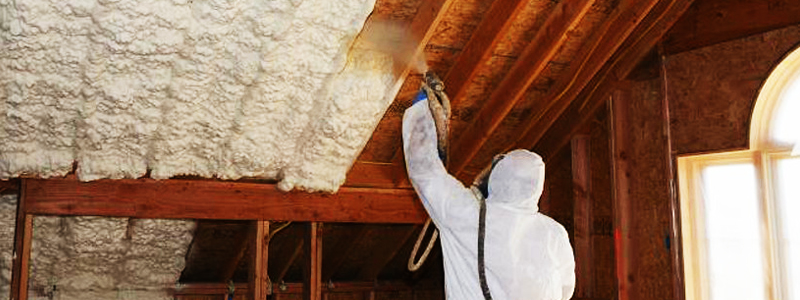Insulating Spray Foam DIY
DIY spray foam insulation is the easiest way to stop leaks and exposed areas inside your property and on your roof. Most hardware supply stores sell spray foam insulation in easy to use kits, making it convenient for anyone to use.
You can use DIY spray foam insulation kits to seal cracks and enhance the insulation of your property. For example, you can insulate your crawlspaces, rim joists, and other areas with cold air or moisture leaks. These insulating materials are dense enough to seal roof membranes that have minor damage.
Read on and learn more about how to use DIY spray foam insulation.
What is DIY Spray Foam Insulation?
Spray foam insulation is a liquid-based material that hardens enough to seal walls, floors, and ceiling cavities against air and water leaks. They create an airtight barrier that allows properties to introduce complete insulation.
Insulation introduces numerous benefits for properties. It will save money from utility bills due to the better retention of internal temperature. It also reduces noise pollution. The spray foam barrier’s density halts air, which is the primary transport medium of sound waves.
Spray foam insulation kits are readily available because manufacturers recognize air leakage as a primary problem for virtually every property.
How Do They Work?
Once you spray the foam insulation material into a crack or crevice, the liquid-based material rapidly expands up to 100 times its original size allowing it to completely fill the gap. Its expansion halts once it has covered every cavity.
Polyurethane foam insulation is made up of two components, isocyanates, which are highly-reactive and dense, and a compound of polyol, flame retardants, and amine catalysts. The interaction of the two chemicals inside the tank allows it to remain in a viscous, semi-liquid form. Upon application, the compound expands and hardens as it dries.
Other Types of Insulation
There are three major types of property insulation materials and methods. One is the polyurethane spray foam discussed above. The two others are fiberglass and cellulose.
Cellulose: These materials are either loose-fill or blown-in and are typically used when constructing enclosed new or existing wall cavities. Cellulose insulation materials are useful in sealing any wall or roof damage, but it does not expand twice its size to provide an airtight seal unlike spray foams. They are made of 75% recycled paper fiber and 15% boric acid or ammonium sulfate.
Fiberglass: Contractors often fit them in unfinished walls, floors, and ceilings. They are made of tiny glass fibers with a plastic compound, giving them additional strength than cellulose or polyurethane spray foams. However, they do not expand and introduce airtight seals.
DIY Spray Foam Insulation: Basic Roof Application
- Make sure to read the instructions the manufacturer provided before using the DIY spray foam insulation. Put on the right equipment, such as your hooded suit, gloves, facemask, and eye protector.
- Assemble the spray gun and secure the canisters.
- Double-check the canisters to ensure they are hooked up in a proper manner. Failing to do so could result to ruined mixtures, which will render them useless.
- Point the spray snout towards the affected area and allow the compound material to fill the gap. Take care in applying the polyurethane material because foam will stick to everything.
Beyond Roofs: Typical DIY Spray Foam Applications
With enough experience in applying r membranes and fixing its other damages, anyone apply the DIY spray foam insulation efficiently. Polyurethane foam is usually used in the following areas of the house:
Roof Surface
Using a marker, label the areas of your roof that have damages or small vent areas that allow air to escape. Taking inventory of these allows you to measure the amount of spray foam you will need to apply. Most roofing materials can accommodate the strong, single-ply membrane-equivalent protection of spray foam insulation.
Mix the polyurethane foam material efficiently. Apply enough amounts and avoid over-filling the gaps. Make sure to use a small wood plank to shave off excess foam material.
Crawlspaces
Crawlspaces introduce condensation in a property. Aside from poor insulation conditions, crawlspaces make homes for pests such as rodents, mildew, and algae. To eliminate moisture entry and development into your crawlspace, it is essential to insulate them.
Insulate the walls of your crawlspaces and use rigid boards to help support the small plastic and vapor barriers that will help prevent outside air from penetrating the small cavity.
Basement Walls
Closed-cell spray foams are efficient for basements because it seals cracks preventing air from condensing inside basements. The excellent seals also prevent mold, bugs, rodents, and other life forms from taking hold of the area.
Joists and Sill Plates
Even in modern properties, rim joists have no insulation and the sheathing and siding they have are not enough to prevent outdoor air from entering the property. Rim joists meet with the foundation wall, mudsill, and the subfloor. By applying DIY spray foam insulation in these areas, you prevent air leakage and even moisture from entering your property.
Filling Walls
You can use open or closed-cell polyurethane foam to seal cracks and other damages in your internal and external roofs. Foam expands 100 times its size when applied on cracks, allowing you to repair them good as new.
HVAC Ducts
Leaks in your HVAC system’s ducts cause external temperature to contaminate the supplied air. In consequence, it increases your energy bills due to weaker output. Small amounts of spray foam will fix duct system damages and introduce airtight plugs that prevent leakage and air contamination.
Soundproofed Internal Walls
Energy bill reduction is just one advantage of insulation. Spray foam insulation material creates another solid barrier against airflow and it is dense. Materials such as concrete and thick mattresses slow the movement of air molecules, which bring vibrations. Therefore, an insulated property is a quieter one with soundproofed internal walls.
Conclusion
DIY spray foam insulation kits are easy to learn and there are a huge number of benefits you can enjoy using it to insulate your property. However, it may take time for you to get used to using the spray equipment. The likelihood of first-time use failure is also high. Therefore, it would be best to consult professionals to help you apply spray foam insulation on your roof effectively.

